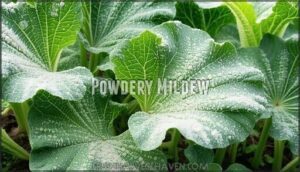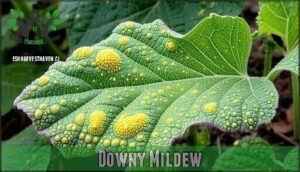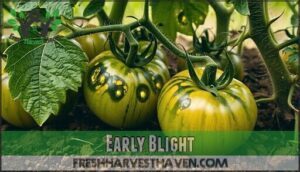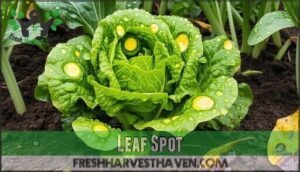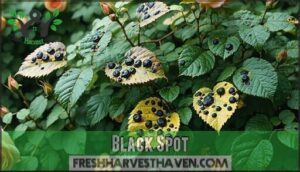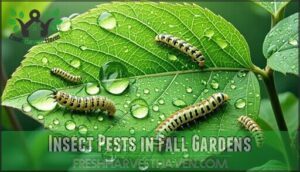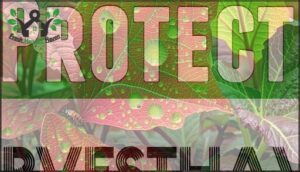This site is supported by our readers. We may earn a commission, at no cost to you, if you purchase through links.
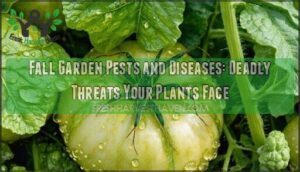 Your fall garden faces several threats that can devastate your harvest if left unchecked.
Your fall garden faces several threats that can devastate your harvest if left unchecked.
Common fall garden pests and diseases include powdery mildew coating your squash leaves like flour, aphids clustering on tender growth, and early blight creating dark spots on tomatoes.
Downy mildew thrives in cool, wet conditions while black spot targets roses.
Cabbage worms and loopers can strip brassicas bare overnight, and armyworms march through crops like tiny soldiers.
You’ll also battle harlequin bugs that pierce plant tissues.
Prevention beats treatment every time – proper spacing, watering at soil level, and removing infected debris work wonders.
The key lies in recognizing these villains early and knowing exactly which tactics stop them cold, which is why early recognition and proper spacing are crucial, and using the right tactics can stop pests cold.
Table Of Contents
- Key Takeaways
- Common Fall Garden Diseases
- Fungal Disease Prevention
- Insect Pests in Fall Gardens
- Protect
- Frequently Asked Questions (FAQs)
- What is the most common pest in the garden?
- What is killing my vegetable garden?
- What is the best pest control for vegetable garden?
- What is the most damaging crop pest?
- How to get rid of overwintering garden pests?
- Do I need pest control in the fall?
- How do I identify my garden pest?
- What kind of bugs come out in fall?
- What should I do for my garden in the fall?
- What pests are in fall?
- Conclusion
Key Takeaways
- Prevention beats treatment – You’ll save time and crops by spacing plants properly, watering at soil level, and removing infected debris rather than fighting established problems.
- Early detection is critical – You need to inspect your plants weekly, checking leaf undersides where pests hide, since diseases and insects can devastate crops within days once they take hold.
- Fall conditions favor fungal diseases – Cool, damp autumn weather creates perfect conditions for powdery mildew, downy mildew, and early blight, so you must improve air circulation and avoid overhead watering.
- Target specific pests with proven methods – You can control aphids with water sprays and beneficial insects, stop cabbage worms with Bt spray, and eliminate armyworms through evening inspections and natural predators.
Common Fall Garden Diseases
Your fall garden faces several serious fungal diseases that can devastate your crops if left unchecked.
These diseases thrive in autumn’s cool, damp conditions and can spread rapidly through your plants, causing significant damage to leaves, stems, and fruits, especially in autumn’s cool environment.
Powdery Mildew
When you spot powdery mildew’s signature white, flour-like coating on your plants, you’re witnessing one of fall’s most common fungal diseases.
This sneaky invader blocks sunlight and steals nutrients, weakening your garden’s productivity. Mildew identification starts with recognizing those telltale white patches on leaves, stems, and flowers.
Here’s your battle plan against this persistent threat:
- Improve air circulation by pruning overcrowded areas and spacing plants properly
- Apply organic treatment options like diluted milk spray (1:10 ratio) or neem oil
- Choose resistant varieties such as zinnias ‘Zahara’ or cucumbers ‘Marketmore’
- Water at soil level during morning hours to prevent spore dispersal
Disease prevention beats treatment every time. To combat this issue, consider specialized mildew products for effective control.
This fungal disease thrives in humid conditions with poor airflow, making fall gardens particularly vulnerable. Host plants like beans, squash, and melons are especially susceptible. Swift action protects your harvest from this common fall garden disease.
Downy Mildew
When cool environments meet high humidity, downy mildew strikes your fall garden with devastating precision. This fungal disease creates yellow spotting on leaf surfaces while producing fuzzy growth underneath leaves that appears grayish-purple.
Unlike other fall garden diseases, downy mildew thrives in temperatures between 50-68°F with prolonged leaf wetness. You’ll spot infected leaves turning brown and curling before dying completely.
Effective disease control requires immediate action:
- Switch to drip irrigation to keep foliage dry
- Increase plant spacing for better airflow
- Remove infected plant material immediately
- Apply copper-based fungicides preventively
To combat this, consider using a downy mildew fungicide for effective control. Disease prevention starts with proper watering habits and garden design—don’t let this silent destroyer claim your harvest.
Early Blight
While downy mildew attacks from above, early blight strikes from below, targeting your tomato and potato plants with devastating precision.
This fungal menace creates distinctive dark, target-like rings on lower leaves first. Tomato defoliation begins as these spots expand, turning leaves yellow before they drop. Potato blight follows similar patterns, weakening plants substantially.
Dark rings spreading upward spell doom for your tomato harvest.
Watch for these warning signs:
- Concentric dark rings on older leaves
- Brown lesions spreading upward on stems
- Sunken, dark spots on fruits near stems
- Progressive yellowing and leaf drop
- Fruit impact showing dark, leathery patches
Spore survival through winter makes prevention critical. Plant resistant varieties like ‘Mountain Fresh Plus’ tomatoes. Remove infected debris immediately since spores persist in plant material. Water at soil level to prevent splash-back infection. Disease control requires consistent monitoring and quick action when symptoms appear.
Leaf Spot
Beyond early blight’s damage, leaf spot presents another significant fungal disease threat to your fall garden. Over 100 fungal diseases cause these distinctive lesions, creating brown, black, or yellow marks with defined margins on foliage.
Leaf Spot ID involves recognizing circular to irregular spots, often with yellow halos or concentric rings. Affected Plants include lettuce, spinach, beets, and ornamental flowers like zinnias.
Environmental Factors like prolonged leaf wetness and moderate temperatures (60-80°F) promote spread. Poor air circulation in dense plantings increases humidity, creating ideal conditions for plant disease identification.
Preventative Measures include removing infected debris, avoiding overhead watering, and improving garden spacing. To further bolster plant defenses, consider choosing resistant varieties. Treatment Options involve copper-based fungicides for persistent infections and proper sanitation practices to limit plant disease leaf spots transmission between plants.
Black Spot
Black spot devastates rose gardens when humid conditions create perfect breeding grounds for this persistent fungal disease.
This common garden fungus causes distinctive black spots on rose leaves, leading to rapid leaf drop that weakens plants substantially. Rose blackspot thrives in fall’s damp weather, making proactive black spot control essential for healthy rose care.
- Remove infected foliage immediately to prevent fungal diseases from spreading throughout your garden
- Improve air circulation through strategic pruning methods that reduce humidity around plant bases
- Apply preventive treatments during fall garden pests season to protect against future outbreaks
Fungal Disease Prevention
Protecting your plants from fungal diseases requires proactive strategies that target the root causes of infection. Disease prevention starts with understanding how garden fungus spreads and thrives in fall conditions.
- Improve airflow importance: Space plants properly to reduce humidity and prevent plant fungus from establishing in stagnant air pockets.
- Master watering practices: Water at soil level during morning hours to keep foliage dry and discourage fall garden disease development.
- Practice debris removal: Clear infected plant material and practice tool disinfection to eliminate disease sources that overwinter in garden beds.
- Choose resistant varieties: Select plants bred to withstand common fungal diseases, giving your garden a natural defense advantage. To further bolster defenses, consider how wide spacing reduces humidity.
Insect Pests in Fall Gardens
While your summer garden battles heat and drought, fall brings a different set of challenges as cooler temperatures and increased moisture create perfect conditions for insect pests to thrive.
These opportunistic invaders can quickly destroy your autumn harvest if you don’t recognize their warning signs and act fast to address the warning signs.
Aphids
While proper garden hygiene prevents many diseases, aphids present a different challenge altogether. These tiny green insects multiply rapidly throughout fall, creating colonies that can devastate your plants within weeks.
Aphid damage starts subtly with curling leaves, but quickly escalates to yellowing foliage and stunted growth. The aphid lifecycle accelerates in cooler weather, with females producing dozens of offspring without mating. You’ll notice sticky aphid honeydew coating leaves, which attracts black sooty mold and creates additional problems.
Aphid control requires swift action. Spray infested plants with water to dislodge clusters, then apply insecticidal soap or neem oil for persistent populations. To address infestations, consider using an appropriate control spray. Aphid predators like ladybugs and lacewings provide natural control—attract them by planting flowers nearby.
Monitor your fall garden pests weekly, checking leaf undersides where aphids hide. These garden insects transmit over 100 plant viruses, making early pest control critical for protecting your harvest.
Harlequin Bugs
While aphids drain nutrients from your plants, harlequin bugs take a more destructive approach to fall garden pests. These shield-shaped insects measure 12-14 mm with distinctive black and orange markings that make them easy to spot on your brassica family crops.
Harlequin bugs pierce plant tissue and suck sap, creating yellow spots that turn brown and lead to wilting. Their bug lifecycle includes overwintering in plant debris, making fall cleanup part of effective brassica pest control.
Young plants suffer the most severe harlequin bug damage, with infestations potentially killing entire crops within days. One preventative measure includes sealing potential pest entry points around the garden.
- Manual removal combined with row covers provides immediate integrated management results
For organic solutions, plant mustard as trap crops and encourage natural predators like parasitic wasps. Remove all plant debris after harvest to break their lifecycle and prevent next season’s vegetable garden pests problems.
Armyworms
While harlequin bugs target specific plants, armyworms march through gardens like tiny soldiers on a mission.
These fall garden pests start their armyworm lifecycle as moth eggs that hatch into hungry caterpillars within days.
You’ll recognize their nocturnal feeding habits by checking plants in the evening when they’re most active.
Bt for effective control
Watch for irregular foliage damage patterns across your vegetable garden.
These pest identification clues help you spot trouble early.
Natural predators like birds and parasitic wasps provide biological control, but severe infestations need immediate attention.
Control methods include Bacillus thuringiensis applications and cultural practices.
Don’t wait – armyworms can strip entire crops within days once they establish themselves, which is why it’s crucial to practice fall prevention tactics and encourage natural predators to maintain a healthy garden ecosystem, utilizing methods like Bt for effective control.
Cabbage Worms
Unlike armyworms that travel in destructive groups, cabbage worms work alone to systematically destroy your fall brassicas. These bright green caterpillars with faint yellow stripes create large, irregular holes throughout cabbage, kale, and collard leaves.
You’ll spot a cabbage worm invasion by watching for these warning signs:
- White butterflies with black spots hovering around your garden
- Tiny white eggs clustered on leaf undersides
- Large ragged holes concentrated along leaf midribs
- Dark green frass identification pellets scattered on damaged foliage
Their life cycle spans about 30 days, with multiple generations per season making continuous monitoring essential. For effective brassica protection, hand-pick visible larvae during morning inspections. Bacillus thuringiensis (Bt) provides targeted organic control without harming beneficial insects.
Preventative measures include floating row covers that block egg-laying butterflies while allowing air circulation. Apply Bt every 7-10 days during peak butterfly activity for consistent brassica protection.
Cabbage Loopers
Cabbage loopers create large, irregular holes in your brassica leaves while moving with their signature arching motion.
These green caterpillars with white stripes differ from regular cabbage worms through their distinctive Looper Lifecycle and movement pattern. Looper Identification becomes easier when you spot their characteristic inch-worm crawling style.
Looper Damage includes extensive leaf destruction and sticky frass deposits.
Control them using Bacillus thuringiensis (Bt) spray, Natural Predators like parasitic wasps, or Organic Control methods including neem oil and row covers. Natural pest control methods work best with early detection and consistent monitoring.
Protect
Protecting your fall garden requires a multi-layered approach that strengthens your plants’ natural defenses. Start by boosting Soil Health through compost additions, which enhances Plant Immunity against diseases and pests. Strong Garden Hygiene practices eliminate hiding spots for overwintering pests by removing garden debris and infected plant material promptly.
Implement these fall prevention tactics for maximum protection:
- Crop Rotation reduces soil-borne disease incidence by up to 70%
- Beneficial Insects like ladybugs and lacewings provide natural fall pest control
- Regular garden cleanup removes pest breeding grounds and disease sources
These integrated strategies create a protective barrier without chemicals. You can also use natural herbal repellents like neem oil to disrupt pest breeding. Your plants develop stronger resistance when you combine proper soil management with biological controls. Consistent monitoring and early intervention complete your defense system, ensuring healthier harvests throughout the season.
Frequently Asked Questions (FAQs)
What is the most common pest in the garden?
Picture your garden as a bustling restaurant where uninvited guests crash the party.
Aphids are typically the most common garden pest, draining plant nutrients and causing leaf curling, yellowing, and sticky honeydew deposits throughout the growing season, which can be considered a significant garden pest issue.
What is killing my vegetable garden?
Several culprits could be destroying your vegetable garden.
Fungal diseases like powdery mildew, downy mildew, and early blight thrive in fall’s cool, damp conditions.
Common pests include aphids, cabbage worms, and slugs that feed aggressively before winter arrives.
What is the best pest control for vegetable garden?
Crop rotation reduces soil-borne disease incidence by up to 70% in fall gardens. You’ll get best results combining neem oil, beneficial insects like ladybugs, and proper spacing for airflow.
What is the most damaging crop pest?
Aphids top the list as your garden’s most destructive pest, draining nutrients from plants while transmitting over 100 different viruses that can devastate entire crops.
How to get rid of overwintering garden pests?
Clear garden debris and fallen leaves where pests hide.
Use beneficial insects like ladybugs for natural control. Apply neem oil or insecticidal soap treatments.
Practice crop rotation to break pest cycles effectively.
Do I need pest control in the fall?
Yes, you’ll need pest control in fall. Many insects like aphids, cabbage worms, and armyworms remain active, while fungal diseases thrive in cool, damp conditions, potentially damaging your harvest.
How do I identify my garden pest?
Like a detective examining clues, inspect your plants weekly for telltale signs.
Look for chewed leaves, discoloration, sticky residue, or small moving insects.
Check undersides of leaves where pests often hide.
What kind of bugs come out in fall?
Fall brings aphids, cabbage worms, harlequin bugs, armyworms, slugs, winter cutworms, and grubs. You’ll also notice increased squirrel activity as they prepare for winter storage.
What should I do for my garden in the fall?
As autumn’s curtain falls on your garden, you’ll need to clear debris, plant cool-season vegetables, add compost, mulch beds, and inspect for pests weekly to maintain healthy growth.
What pests are in fall?
You’ll encounter aphids draining nutrients from plants, cabbage worms chewing irregular holes in brassicas, armyworms feeding at night, slugs thriving in damp conditions, and cutworms cutting young plants at their base.
Conclusion
Surprisingly, your garden’s biggest enemies often arrive when you least expect them.
Fall garden pests and diseases strike during harvest season, turning months of hard work into disappointment.
However, you’re now equipped with the knowledge to identify these threats before they spread, and prevention through proper spacing, soil-level watering, and debris removal works better than reactive treatments.
Stay vigilant, act quickly when problems appear, and you’ll protect your autumn harvest from these destructive invaders, ensuring a successful harvest through proper spacing and debris removal.

